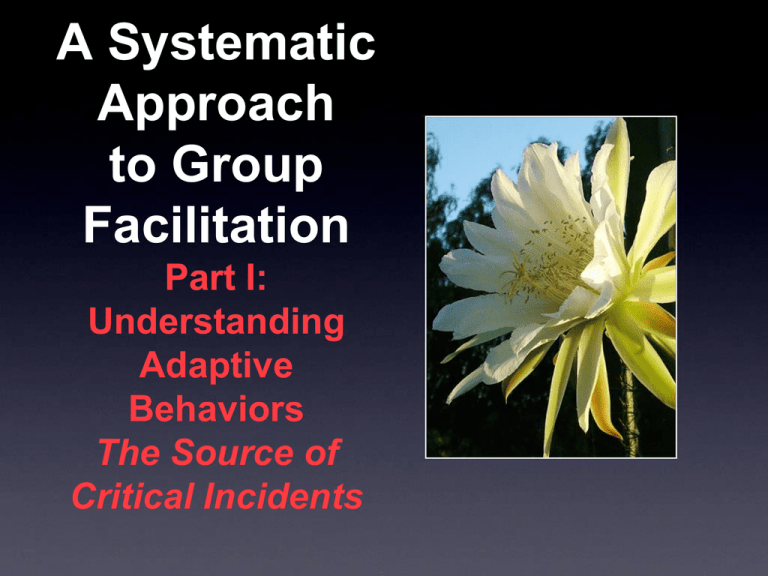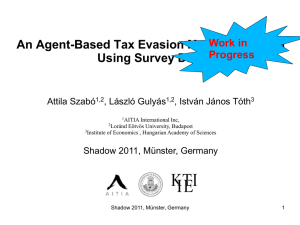Adaptive Behavior Downloadable Powerpoint
advertisement

A Systematic Approach to Group Facilitation Part I: Understanding Adaptive Behaviors The Source of Critical Incidents Critical Incidents in group therapy • The key to working with groups is being able to anticipate and use “critical incidents” whenever they arise. • Critical incidents are those defining moments in which a group confronts a serious interpersonal issue, and must deal with it. • In order to benefit from critical incidents, rather than being upset by their emergence, it is important to understand their origin. Critical incidents occur, in part, when a group member is engaged in “adaptive behavior” to the extent that it causes a disruption in the group Definition: Adaptive Behavior is anything a person does repeatedly in relationships that stands in the way of becoming close or intimate with others Two Types of Adaptive Behavior: Reactive and Compliant • Reactive comes from early loss or trauma and leads to compensatory behavior, or “interpersonal camouflage.”(safe vs. dangerous) • Compliant comes from imitating parents or societal injunctions and leads to the suppression of the shadow self. (good vs. bad) Reactive Adaptive Behavior Trauma or loss (“Y”) gives rise to Belief: I caused “Y” by doing “X” This gives rise to Formula: If I don’t do “X” then “Y” won’t happen again or If I do the opposite of “X” then “Y” won’t happen again This gives rise to Adaptive behavior that protects the person from real or imagined rejection or hurt The Origins of Compliant Adaptive Behavior: the Development of the Shadow Self • At an early age, a child is rewarded for being a certain way, and punished for being otherwise. • When the child begins to comply with the ideals of the parents, and behave accordingly, there begins to be a division within the self that results in a repression of a “shadow self.” • The shadow is comprised of everything considered unacceptable by one’s parents and society. Before long, the child loses touch with this repressed self. The public self continues to perform in order to “be good” and gain acceptance. The shadow remains unknown, and expresses itself in dreams in through projections onto others, who are different. The Shadow, continued • The counselor’s reactions to clients is one way that the counselor gets in touch with his or her own shadow self • The group members’ reactions to each other also provides clues about the shadow self. • Withdrawing the projection of the shadow, and owning one’s repressed nature is a feat of monumental proportions. • The end result is reintegration and wholeness. Getting in touch with the Shadow • Look at your dreams. • Look at your negative reactions to other people. • Look at the words you use to describe your ideals for yourself. What are the opposites of these words? The opposite terms will describe the shadow self. The Group leader’s role: to become aware of, and to confront adaptive behavior in such a way that the person is not mistreated or made to feel ashamed, and the group grows closer as a result... a tall order! A Systematic Approach to Facilitating Group Process Around Adaptive Behavior, or the OIDFS System • Observation • Inquiry • Disclosure • Facilitation of group interaction • Structure Statement Observation Attention to process, not content • Focus on what is going on as one person speaks. • Focus on verbal and nonverbal behavior of members, including the one speaking. • Become aware over time of repetitive behaviors that may be adaptive, but not useful for the person or the group. • Make an observation without interpretation in this form: “Jack, I’ve noticed that you... Inquiry • Once you made an observation without interpreting the person’s behavior, ask an open-ended question, such as... • Can you tell us what is going on? • Can you tell us what you are feeling? Facilitation of Group interaction • Give the person adequate time to respond. Then, regardless of what the person says, you need to get the group interacting around the intervention: • If the person says “nothing...” ask the group if anyone else has noticed the behavior, and what reaction they have to it. (Do not allow interpretation!) • If the person gets in touch with a feeling or reaction that needs to be expressed, have the person communicate this to the group, or to a specific member. • Then encourage response to the person’s disclosure. Structure Statement (optional) • Once the group has sufficiently processed the event, it is often important for you to put the event in a positive and meaningful light, by using a structure statement, which does the following: • Summarizes what has taken place. • Acknowledges the courage that it took for the member to get in touch with and communicate a sensitive issue. • Acknowledges the value of what has taken place, and encourages other members to be so bold. Summary, continued • A respectful, non-interpretive observation creates the conditions for a person to become aware of his or her behavior. • Open-ended inquiry permits a person to respond without constraint. • Facilitating group interaction can reap more benefits for the person, and well as the other group members. • A structure statement underscores the positive value of such stressful exchanges. Summary • Adaptive behavior can limit a group’s progress. • Even if adaptive behavior once was useful as protection against real threats (reactive), or as a way to gain approval (prescriptive), adaptive behavior is usually no longer necessary and useful. • Adaptive behavior is largely unconscious, and needs to be brought to a person’s awareness, so that corrective emotional experiences can ensue. Corrective Emotional Experiences A Group Member’s peak experience • When a group member awakens to the fact that they can express themselves more honestly and that... • certain avoided interpersonal behaviors can actually be okay, and • certain repetitive interpersonal behaviors are no longer necessary Remember! One person’s adaptive behavior is another person’s breakthrough. We all are different, and we have different requirements for balancing our lives.








